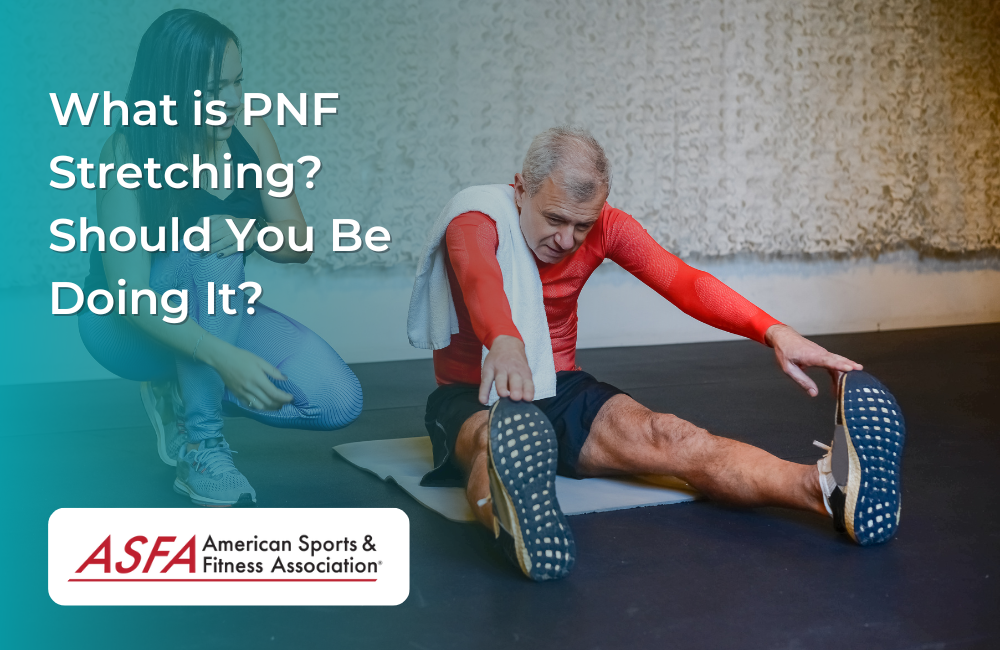Stretching is an important part of any workout routine. It helps keep your muscles loose and flexible, making it easier to do other exercises and avoid injury. There are many different types of stretching, including static and dynamic stretches. People may have also talked about PNF stretching or proprioceptive neuromuscular facilitation (PNF). PNF is a type of active stretching that focuses on the agonist-antagonist muscles—the two sets of muscles that work together but are opposite in action. The muscle is stretched to its maximum point, followed by a brief contraction of the antagonist or opposing muscle group (i.e., biceps/triceps), which helps increase flexibility and range of motion while reducing pain during exercise or movement activities.
PNF stretching is a type of stretching that focuses on the agonist-antagonist muscles.
The muscle is stretched to its maximum point, followed by a brief contraction of the antagonist or opposing muscle group. This process is repeated several times for each muscle group to be stretched.
PNF stretching works because it increases blood flow to your muscles, helps you relax your body, and improves flexibility and range of motion in your joints.
The muscle is stretched to its maximum point, followed by a brief contraction of the antagonist or opposing muscle group.
PNF stretching is a type of static stretching that involves holding a muscle in its end range for an extended period of time, followed by a brief contraction (or 'twitch') of the antagonist muscle group.
For example: If you were to stretch your hamstring muscles, you would extend them as far as possible and then contract your quadriceps muscles for several seconds before allowing them to relax again.
This process is repeated several times for each muscle group to be stretched.
The PNF technique is a type of stretching that focuses on the agonist-antagonist muscles. Stretching is an important part of a healthy lifestyle, as it helps to improve flexibility, reduce soreness and tension in your muscles, increase blood flow to the tissues, and aid in injury prevention.
Stretching involves lengthening your muscles by exerting gentle force against them. The more slowly you stretch, the easier it will be for your body to relax into the stretch and allow you time for proper alignment during each repetition (or cycle).
The P stands for proprioception, which refers to your ability always to know where your body parts are.
PNF stretching is active stretching that focuses on improving your proprioception, which is knowing where your body parts are at all times.
PNF stands for proprioceptive neuromuscular facilitation and stands out from other forms of stretching because it involves progressively increasing tension on the muscle being stretched. The P in PNF stands for proprioception, which refers to your ability always to know where your body parts are. Proprioception is important for balance and motor control; some people have better proprioception than others.
The N is for neuromuscular facilitation or neuro facilitation.
PNF stretching is a technique that uses the nervous system to increase muscle length. The name PNF comes from its two main components:
- PNF stands for proprioceptive neuromuscular facilitation or neuro facilitation.
- Proprioception is your body's ability to sense its position in space and react accordingly (i.e., if your foot hits something on the ground, you automatically move it).
- Neuromuscular refers to how nerve cells control muscles (the nervous system).
PNF stretching involves contracting one set of muscles while simultaneously relaxing another via the nervous system, which causes them both to relax into deeper stretches than they would otherwise allow on their own. This technique can be used before exercise as part of an active warmup routine or after exercise has already been completed as part of an active cool-down routine; however, there are some concerns about whether this type of static stretching should be done before working out.
This refers to how much your nervous system needs to be challenged for the body to make big changes in flexibility and range of motion.
PNF stretching is the process of creating a new motor program. Your nervous system needs to be challenged for the body to make big changes in flexibility and range of motion.
This refers to how much your nervous system needs to be challenged for the body to make big changes in flexibility and range of motion.
The best way I've found this explained was by looking at it from an example: If you hold onto a pullup bar with your arms at 90 degrees (elbows bent), then do some pushups, your shoulders will get stronger because they're working harder than usual during those movements. This is neuromuscular facilitation at work!
Stretching can be painful if done incorrectly, so it's best to have someone experienced to show you how to do it right before attempting it yourself.
If you're new to stretching and want to start a routine, it's best to have someone experienced to show you how to do it right before attempting it yourself. If you are doing PNF stretching independently, ensure the stretches are not painful or uncomfortable. While performing these stretches, you should feel tension but no pain in any part of your body.
If a stretch causes pain or discomfort in any part of your body and continues after warming up with some light cardio activity (such as walking), then stop immediately and consult with an experienced trainer or physical therapist who can help guide you through the proper form so that neither overstretching nor under stretching occurs when stretching muscles during exercise routines such as weightlifting sessions at gyms across America every day!
Conclusion
This article has helped you understand the benefits of PNF stretching and how it can be used in your daily life. If you're looking for more information on how to do it correctly, I recommend finding a certified trainer or physical therapist to show you how to properly perform each stretch without hurting yourself.





